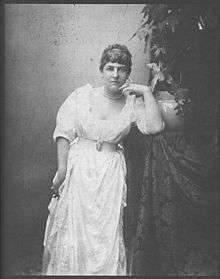Fanny Stevenson
| ||||||||||||||
Frances (Fanny) Matilda Van de Grift Osbourne Stevenson (10 March 1840 – 18 February 1914) was the wife of Robert Louis Stevenson and mother of Isobel and Lloyd Osbourne.
Early life
Fanny Vandegrift was born in Indianapolis, the daughter of builder Jacob Vandegrift, and his wife Esther Thomas Keen. She was something of a tomboy, and had dark curly hair. At the age of seventeen she married Samuel Osbourne, a lieutenant on the State Governor's staff. Their daughter Isobel (or 'Belle') was born the following year.
Samuel fought in the American Civil War, went with a friend sick with tuberculosis to California, and via San Francisco, he ended up in the silver mines of Nevada. Once settled there he sent for his family. Fanny and the five-year-old Isobel made the long journey via New York, the isthmus of Panama, San Francisco, and finally by wagons and stage-coach to the mining camps of the Reese River, and the town of Austin in Lander County. Life was difficult in the mining town, and there were few women around. Fanny learned to shoot a pistol and to roll her own cigarettes.
The family moved to Virginia City, Nevada. Samuel began going with saloon girls, and in 1866 he headed off gold prospecting in the Coeur d'Alene Mountains, and Fanny and her daughter journeyed to San Francisco. There was a rumour that Sam had been killed by a grizzly bear, but he returned to the family safe, and a second child Samuel Lloyd was born in 1868. But Samuel continued philandering and Fanny returned to Indianapolis.
The couple were reconciled again in 1869, and lived in Oakland where a second son, Hervey, was born. Fanny took up painting and gardening. However, Sam's behaviour did not improve, and Fanny finally left him in 1875 and moved with her three children to Europe. They lived in Antwerp for three months, and then to allow Fanny to study art, they moved to Paris where Fanny and Isobel both enrolled in the Académie Julian. Hervey, sick with scrofulous tuberculosis, died on 5 April 1876, and was buried in a temporary grave at Père Lachaise Cemetery.
With Stevenson

While in Paris, she met and befriended Robert Louis Stevenson. Convinced of his talent, she encouraged and inspired him. He became deeply attached to her, but Fanny returned abruptly to California.
Stevenson announced his intention of following her, but his parents refused to pay for it, so he saved for three years to pay his own way. In 1879, despite protests of family and friends, Stevenson went to Monterey, California, where Fanny was recovering from an emotional breakdown related to indecision about whether to leave her philandering husband. Stevenson wrote many of his most 'muscular' essays in Monterey while awaiting Fanny's decision.
The lady ultimately chose Stevenson, and in May 1880, they were married in San Francisco. A few days later, the couple left for a honeymoon in the Napa Valley, where Stevenson produced his work Silverado Squatters. He later wrote The Amateur Emigrant in two parts about his passage to America: From the Clyde to Sandy Hook and Across the Plains. His middle-class friends were shocked by his travel with the lower classes; it was not published in full in his lifetime, and his father bought up most copies.
In August 1880, the family moved to Great Britain, where Fanny helped to patch things up between Robert and his father. Always in search of a climate conducive to Stevenson's ailing health, the couple travelled to the Adironacks in the US. In 1888, they chartered the Casco out of San Francisco and sailed to Western Samoa. Later voyages on the Equator[1] and Janet Nicoll with Lloyd followed.[2] They settled in Upolu, at their home Vailima, where Stevenson died on 3 December 1894.
Return to California
After his death, Fanny returned to California to begin a new life in America and Europe with an adoring companion decades her junior, newsman Ned Field.
Death
When Fanny died in Santa Barbara, California on 18 February 1914, Edward Salisbury Field (1878–1936), her last companion-in-adventure, described her as "the only woman in the world worth dying for." Later on he married her daughter Isobel Osbourne (1858–1953). In 1915, Fanny's ashes were taken by her daughter to Samoa where they were interred next to Stevenson on top of Mount Vaea.[3] The bronze plaque for Fanny bears her Samoan name 'Aolele' (Flying Cloud in Samoan).[4]
References
- ↑ In the South Seas (1896) & (1900) Chatto & Windus; republished by The Hogarth Press (1987). A collection of Stevenson's articles and essays on his travels in the Pacific
- ↑ The Cruise of the Janet Nichol Among the South Sea Islands, A Diary by Mrs Robert Louis Stevenson, Charles Scribner's Sons, New York, 1914, republished 2004, editor, Roslyn Jolly (U. of Washington Press/U. of New South Wales Press)
- ↑ Terry, Reginald Charles (1996). Robert Louis Stevenson: interviews and recollections. University of Iowa Press. p. 207. ISBN 0-87745-512-0. Retrieved 1 July 2010.
- ↑ Yousef, Robyn (2013-03-26). "Samoa: Tales of the teller live on". New Zealand Herald. ISSN 1170-0777. Retrieved 2016-11-29.
Further reading
- Dead Man's Chest: Travels after Robert Louis Stevenson, Nicholas Rankin, ISBN 0-571-13808-X
- Tales of Love and Hate in Old San Francisco, Millie Robbins. Chronicle Books, San Francisco 1971. ASIN B0006C0QVA
- Robert Louis Stevenson's Ethics for Rascals, Elayne Wareing Fitzpatrick, Xlibris Books, Philadelphia, 2000. ISBN 0-7388-3548-X
- Fanny Stevenson: Muse, Adventuress and Romantic Enigma, Alexandra Lapierre. Carroll & Graf, N.Y., 1995. ISBN 978-1857023824
External links
- Works by Fanny Van de Grift Stevenson at Project Gutenberg
- Works by or about Fanny Stevenson at Internet Archive
